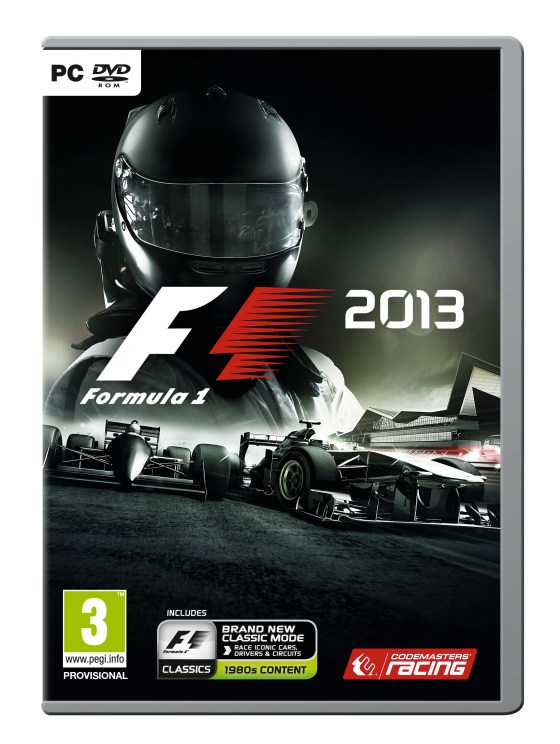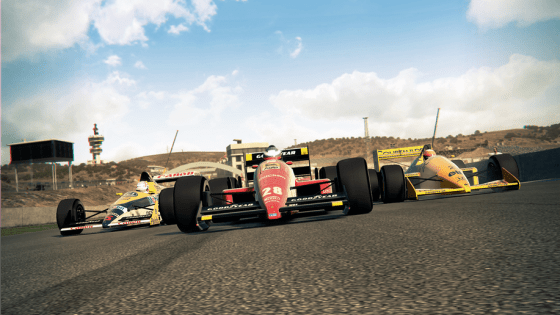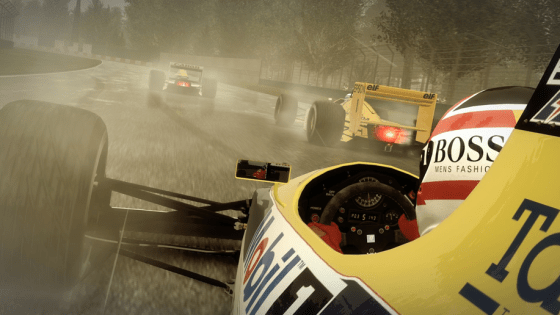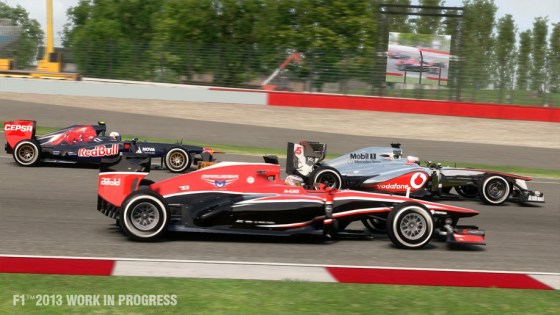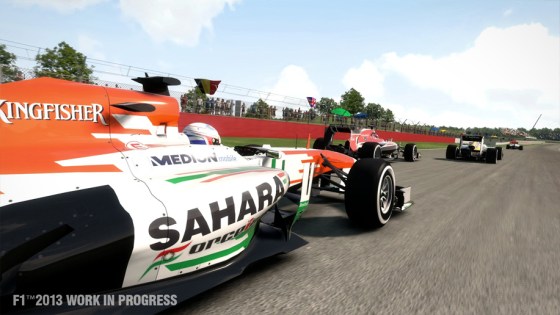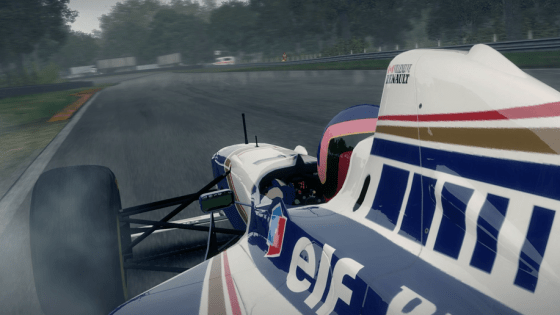Platforms: PC, PS3 and Xbox 360
Reviewed On: PC
Developer: Codemasters
Publisher: Codemasters
Singleplayer: yes
Multiplayer: No
PEGI: 3+
This game was tested using an AMD Radeon HD 7790 graphics card kindly supplied by AMD. Click here for details on that, the Radeon HD 7790 and the test system used for all PC games.
With Codemasters determined to pump out a new F1 game every single year, and with the series now being on its fourth iteration, the company was in slight trouble with this newest release as no new tracks have been added to the F1 calender nor have the cars changed in any significant way. Small tweaks would have of course been welcome to the core gameplay, but without any truly new stuff what reason would anybody have to buy the game?
The answer, in Codemaster’s eyes, was to do something that many, many fans, myself included, wanted desperately: the keys to classic formula one machines from the ’80s, all raring to be taken for a spin by eager players. In Classic Mode you drive such beautiful machines as the 1988 Ferrari F1-87/88C, and what an experience it is: compared to Codemaster’s take on the modern machines the classic’s ooze raw power, allowing you to slide yourself out of corners with a manic grin on your face. While it’s always fascinating to watch the march of technology, in the games the modern race cars are too easy to drive, acting like they’re almost glued to the circuit but these older, more grizzled beasts require respect and a deft touch to pilot around bends, and your reward for doing so is an immense sense satisfaction. While Vettel’s Redbull or Hamilton’s Mercedes must be guided like a scalpel, these turbocharged machines must be muscled, coaxed and forced to do your bidding, snarling their rebellion at every moment. A thin film of yellow grain across the screen aims to replicate the TV viewing experience of the day (and can be turned off), while narration by the legendary Murray Walker almost brought a nostalgic tear to my eye. All through my childhood Murray Walker was the voice of Formula One, and it’s wonderful to hear him again, albeit in a very limited capacity.
For all of the joy of driving historic F1 cars, though, Classic Mode is something of a double-edged sword because after the initial excitement you’ll come to the horrible realisation that it’s probably the biggest wasted opportunity of 2013, or at least that’s how I was left feeling. There’s just five cars available from Ferrari, Williams and Lotus, with the likes of McLaren not even being represented. There’s just two classic tracks in the form of Jerez and Brands Hatch to attempt to tame these wild beasts on, although you can also use them on modern circuits as well in Grand Prix Mode. Nor can you embark on a full season or even career using these cars, Instead you can take part in a grand-prix with a grid of just 10, compete in a time-trial or play through one of only six scenarios. The entirety of Classic mode is seriously lacking in content.
What’s more is that somewhere along the developement process the decision was made to package up 6 classic cars from the ’90s and two tracks for a special “Classic Edition” of the game which costs £10 more than the standard version. That’s six cars and two tracks which could have been given to everybody, that could have significantly fleshed out a mode that is desperately lacking and made it feel worthwhile, rather than what it feels like right now: a hastily put together and tacked on addition.
Still, I am glad Classic Mode is a part of the game. It’s better to have some content rather than none, after all, and getting a chance to fling those beautiful, historic cars around the track is amazing fun. It’s even more fun when you take online to enjoy some action against human opponents, and I have no doubt that Codemaster’s are already lining up some DLC to expand on the Classic Mode. Quite honestly I’d like them to go all out, acquire the licenses and make a standalone F1 game focusing entirely on the ’80s and ’90s, one that not only emphasises the racing but also the fantastic personalities involved at the time. Sadly the very same licensing issues which have plagued this game will likely ensure such a thing shall never occur, much to my own disappointment.
Outside of Classic Mode everything will be instantly familiar to anyone that played the previous entry in the series, both on-track and off. The first thing that you’ll encounter is the Young Driver’s test, which acts as the game’s tutorial and an opportunity for new players to get to grips with these sleek, modern, ultra-powerful cars that will happily spit you into a wall without careful control of throttle and brake. The tests begin simple enough but quickly advance, guiding you through the basics of cornering and into using the likes of KERS and DRS. Thankfully this year you can skip through the Young Drivers test, allowing those who are already familiar with the game to get on with it, although do bear in mind that completing all of the challenges will present you with a wider choice of staring team for career mode. The menus, animations, tests and voice-overs have all been ripped straight out of F1 2012, creating an almost eery sense of deja-vu for me as I clambered into a McLaren to prove my mettle once again. This is the theme that runs throughout F1 2013: deja-vu. Still, small tweaks have resulted in a package that’s better than last years, if only by a small amount.
The meat of the game still resides firmly in the Career mode, where you begin with one of the lower placed teams and proceed to tackle season after season of racing, accepting new contracts with better teams and hopefully winning a championship or three in the process. Outperform your teammate and you’ll take over the number one position within the team, allowing you to alter the research and development path and therefore the upgrades you receive throughout the season. For the full F1 experience you can turn off every driving assist and whack up the AI difficulty to its highest setting while racing full weekends, which means taking part in all of the practice sessions, the entire three-part qualifying and the entire 2-hour race. This may sound like a daunting prospect even to the most hardened of F1 fans, an enjoyable but time-consuming experience which in this fast-paced world of work and sleep few people get the opportunity to fully enjoy. And indeed in previous F1 games playing through career in this way was the territory of only a few select people willing to stay up into the wee hours of the night, but for F1 2013 Codemasters have introduced the small yet significant ability to save mid-session, allowing you to come back later and polish off the remaining laps.
Working your way through multiple seasons remains not only a fun experience but also an incredibly satisfying one, yet same complaints of mine from previous F1 games remain; It was often oddly easy to get something like a Toro Rosso into pole and win the race, even with the AI set to the highest difficulty, I’m happy to report that for 2013 things are a little tougher making for a more authentic experience, yet there’s still plenty of times where I found me and my Marussia or Torro Rosso heading up the grid after qualifying, and while it was hard to maintain such a pace during the race I still found it possible to finish up on the podium. I will concede that this may be deliberate choice on Codemaster’s behalf to ensure that more casual F1 fans don’t have to spend their time fighting tooth and nail just to get into the top ten, but for someone like myself when I ramp up the difficulty it’s because I want that realistic F1 experience, and that means fighting in the middle of the grid for every point I can grab.
Should you wish to embark on something a little lighter Season Challenge lets you pick a team from those that you unlocked during the Young Drivers test and compete in ten predefined races, each one just five laps long. New contract offers come along every couple of races allowing you to quickly fly up the ranks. It’s a lovely lightweight alternate to tackling career mode in all of its glory, providing, along with the new mid-session save system, a great way for you to simply jump in and enjoy the game, but could do with giving players some options to tweak the track selection and amount of laps in each event.
And that’s where the next mode comes into play. After courting a vicious fan backlash for its removal in F1 2012 Codemasters have brought back Grand Prix mode. Here you can choose to race on just a single track or create a season composed of as many of the nineteen modern and two classic circuits you want. After that you’re free to completely customise level of participation for race weekends, deciding whether you’ll go through all three practice sessions and the full three-part qualifying system. Or maybe you’d prefer to do just a single, quick qualifying and move on the race, it’s entirely up to you. You can even have random grids just to keep things interesting. And then of course you can alter how many laps each race will run for. The only downside is that Grand Prix feels like it makes Season Challenge irrelevant in some ways – why race on predefined tracks when you can choose them all yourself, drive for any team you want and set the amount of laps for each? The argument can be made that Season Challenge lets you get into the action a little quicker, but the truth is that setting up your own custom season via Grand Prix takes just a minute or two The only advantage Season Challenge boasts is how it lets you leap from car to car. Should Codemaster include such an option for Grand Prix mode next year, it would be brilliant. Simply said I’m happy to see Grand Prix return: it’s flexibility makes it may number one stop for racing, even above career mode.
More bite sized ways of enjoying the game come in the form of Scenario Mode which has replaced Champion Mode from last years game, yet bears a striking similarity to its predecessor. Each scenario presents you with a completing a challenge using a specific. While Champion Mode limited itself by only including scenarios based around the seven world champions occupying the F1 grid last year, Scenario Mode allows itself more freedom. As a result challenges include trying to achieve a podium from the back of the grid, fending off faster cars, clinching a championship in the space of a few laps and much more. Of course the basic core of each one of these is racing a car just like you do in any of the other of the game’s modes, but it’s just one more way in which F1 2013 is catering to an audience with less time on their hands, while still providing plenty of more time-consuming content for nutters like me who’ll devote hours and hours to the game at a time.
All that’s well and good, though. This is a racing game and what really matters is the on-track action – how do the cars feel, what’s the AI like? Codemaster’s F1 games have arguably one of the most satisfying and beautifully designed handling models in recent memory, so improvement is always tricky. The problem is that without going back and playing dozens upon dozens of hours of F1 2012 to reacquint myself with the handling system’s many nuances it’s hard to talk about what has changed in the 2013 edition, because the tweaks are small and subtle in so many areas. Yet some things do make themselves apparent: the cars feel a little more stable and a little less twitchy when turning, allowing for smoother control in turns, under braking and while sliding. More importantly the tires provide a better sense of progressive feedback to the player, so you can really feel how they’re changing as the race goes on and adapt your driving to suit, creating some tense moments as you near their lifespan and are forced to desperately try and herd the car around every corner as grip wanes. In F1 2012 tires degradation was slow, even when you pushed them to the limits for lap after lap, but in F1 2013 the performance of the tires changes fast. You can feel their performance changes from lap to lap, from corner to corner, and that also means that tire wear comes into play even in short races . As a prime example I was racing at Monza when it the final stages of the race I began to feel the tire’s grip giving way. I had to brake a touch earlier and carry less overall corner speed in order to keep myself from going wide, all the while the Red Bull of Mark Webber ate into my lead. In the final lap the tires hit “the wall”, as it is referred to in the real life sport, and all semblance of grip vanished, leaving me to skitter around the track, ultimately managing to finish ahead of the charging Aussie in his Bull by just 1-second. It was a tension filled race, and one that made me realise I needed to improve my driving in order to make the tires last longer. It’s also something that could never happened in F1 2012. The work that Codemaster has put into the tires this year has certainly been worth it, bringing it a little closer to the real sport. But to get to the point, this is the best iteration of the handling system yet: it feels realistic while still providing enough lenience to ensure you don’t actually have to be a professional racer to stand a chance of winning.

When the rain starts to pour the handling system also feels better than it was. In prior games there were odd moments where you seemed able to use dry weather tires while the track was almost flooded and go flat out, barely sliding and trouncing the AI in the process. With full wet weather rubber on your car staying on the track didn’t feel all that hard, and certainly didn’t seem to resemble the struggle real F1 drivers have. IN F1 2013 when it rains it really rains and dry tires simply don’t cut it anymore, sending you skittering into a barrier at the merest hint of acceleration. Even full wet tires are slippery, giving you reason to pause and mentally adjust your approach to the race. Meanwhile the small upgrades to the handling mentioned above give you a better idea of what your car is doing while on a wet track, allowing you to catch potential spins and slides if you’re fast enough, and thus letting you push yourself that little bit closer to the limit.
My own first experience of rain in F1 2013 came in the most dangerous and challenging place possible: Monoco, a street circuit where you’re never more than a few feet away from walls and barriers, a distance that shrinks to millimetres when racing out of a corner. The rain was hammering down creating pools of water, and even a small slide would see me slamming into something hard, potentially ruining my race. With the cockpit camera on and AI surrounding me the lights went out and the race was on. I immediately hit the throttle and a spray of water surged up from my tires, drenching my helmet with water and obscuring my vision with rivulets of water. Turn one was terrifying as cars jostled for position in the tight corner and I struggled to find any grip.The improved handling let me feel far more subtle movements in the car, and thus began a 15-lap race where I was constantly on the ragged edge, kissing barriers with wheels as I went, sliding, spinning and laughing. Racing in the rain at Monoco with streams of water running down my visor is one of the most fun experiences I’ve ever had in a racing game. That’s the thing about F1 2013, it creates brilliant moments all the time. It’s so easy to fall into the trap of just criticising the game for being largely the same as last years iteration that forget just how much fun playing it is, and how much of a well-rounded racer Codemasters have crafted.
The AI has seen a couple of small tweaks, making them a tad more aggressive in the process and generally just faster. They’re now more willing to place their cars into tiny gaps and race wheel to wheel with you, although sometimes they did get a bit too aggressive, usually resulting in me getting punted off the track. They also seem to react to your presence far better than before, again making for better wheel-to-wheel action. Still some old flaws remain: opponents remain incredibly easy to out-brake, and basic defensive driving on a straight can leave them a little baffled, so with these two things working in tandem keeping the other racers behind you can be a simple affair. These problems aside, though, the AI make for generally good opponents.
But while things like the AI and handling, one area that feels like it has taken a step back is the penalty system, which has always been inconsistent at best. With the more aggressive AI attempting rather optimistic overtaking moves I would both staggered and irritated by the amount of times I was handed a penalty for their rashness. Alonso dived up the inside and shoved his tire into my sidepod, driving me wide, and WHAM! I’ve got a ten-second penalty for causing a collision. Coming into a right-hand corner I’d move slowly back over the left to take the racing line, only to discover Hamilton is going to try to get through that gap, regardless of where I’m obviously moving to. THUD! Another penalty. A car spun me out by hitting my back wheel, and there was another 10-second penalty as my reward for just trying to get around the damn corner. And then came the more baffling instances in which the penalty system failed to do its job completely: I deliberately plowed into the back of Vettel (God, I hate him) at full speed and the mighty God of Penalties ignored my clearly murderous intentions. I slammed into the side of an opponent while attempting an overtake that I am happy to admit was stupid, but again no penalty was applied. Meanwhile when it came to cutting corners the penalty system remained steadfast in its desire to confuse: sometimes merely touching the grass with the inside edge of a single wheel is enough to warrant a warning, while other times using the grass to bypass braking for the corner entirely wasn’t deserving of the God of Penalties attention. The honest truth is the penalty ruined several races for me, forcing me to restart because I’d acquired 30-seconds worth of penalties or simply frustrating me with its inconsistency.
Online play has changed little since last years entry, boasting the exact same three game modes: Sprint is a simple three lap race in the dry, removing the strategy of fuel and tire management in favor of outright speed; endurance ramps up the lap count to 25% of total race distance and enables dynamic weather for more potentially interesting races, while Grand Prix lets you customise everything in the same way that the singleplayer version does. Because of the nature of the game a single idiotic player can ruin an entire session by crashing into everyone, but find a good group of people and F1 2013’s multiplayer is a blast to play as you all fight for position, especially with that small yet delightful chunk of classic content thrown into the mix. However, I did have some problems with lag during the course of test. This may have simply been down to my own connection or poor luck, but it is still worth mentioning here.
The true star of the online side of things, however, remains, in my eyes, the co-op championship in which you and a friend can become teammates and work your way through a full season of F1 action, battling for supremecy. You’ll begin as the best of chums, but it won’t take long for that competitive drive to slowly turn your vision red and your ambitions grander. Before long you’ll pushing yourself and the car to the limit just to be a few tenths of second quicker than your ex-friend. It’s just a shame that you can’t each drive for different teams, but are instead limited to being team mates.
While trackside detail is still somewhat, creating rather flat and lifeless environments, another bevy of small graphical upgrades ensures that F1 2013 looks pretty damn good. The cars themselves are absolutely stunning, their beautifully sculpted lines glinting in the sunlight, while downpours of rain are where the game’s graphic prowess is really shown off with sprays of water erupting from wheels as they pass through standing water and astoundingly realistic looking trickles making their way down your visor in cockpit cam. The weather system is entirely dynamic as well, so while one area of the track has rain lashing down another can be dry or in the processing of drying, allowing the graphics to flex their muscles even more. Damage modelling does continues to be a small blemish in an otherwise fantastic looking game, however, and it’s possible to smash your car into a wall at high-speed with very minimal effect.
Speaking of damage, the safety car still remains a largely underplayed feature, even on tracks where one would really expect it to make an appearance. During my entire testing time with the game I only experienced a safety car once. Even at Monoco in the rain the fabled car never appeared, something which I found hard to believe. If it rained at Monoco in real sport the damn thing would never be in. I assume Codemaster’s want to keep it as a feature that rarely rears its head in order to avoid disrupting the pace of a race too often, but I’d like to see the chances of it increased a little.
Other small changes have had a positive effect on the game. Your race engineer now imparts slightly more helpful information during a race and does so at much more relevant times. There’s still a long way to go before the voice in your eye manages to sound like a convincing facsimile of the real thing, though, and there’s still some problems to be found, like him telling you that you’ve got two laps of fuel left, only for you to run out after just one.
While quick races are great fun it’s really those who are willing to pour oodles of time into the game that will benefit the most as tire management and pitstop strategy turn every race into a game of chess. Outright pace is usually less important than knowing when to push or save the tires, managing fuel and being consistant. Personally, I’m not a fan of the fact that these days tires and pitstops play a far more crucial role in who emerges the victor over the actual driver in Formula One. I’m not a fan of the fact that Hamilton, Alonso and Button all have to race to the limits of the tire rather than the limits of the car and themselves, but there’s no denying that in the game these elements make for fantastic racing. LIkewise it’s also those willing to compete in the full career mode who’ll get the most from the game, the sense of working your way up through the teams to achieve greatness being immensely satisfying.
Refinement over revolution, F1 2013 is Codemaster’s complete and most impressive representation of the sport today, boasting a a brilliant handling model that floats wonderfully between realism and arcade along with enough assists to steer it more toward either end of the scale. As great as it is, though, the improvements here are minimal over last years outing, and possibly won’t even be noticed unless you’ve devoted considerable time to the 2012 edition of the game. The re-use of animations, menus, tests, voice-overs and so much more certainly don’t help the feeling that you’re playing exactly the same game as last year, either. The only big addition here is Classic Mode, and really it’s merely a foundation to be built upon, currently lacking in enough content to entirely justify paying full-price for a lightly tweaked version of F1 2012.
Still, my reservations about how this game was handled aside, F1 2013 needs to ultimately be scored as its own game, and in that it does extremely well. It’s the best F1 game to date, the myriad of small improvements making it a better game that last years iteration, and a solid stepping stone for Codemaster’s entry into the next generation.
The Good:
+ Brilliant handling.
+ Tires behave far better.
+ Throwing a classic machine around a classic track while listening to a classic commentator.
The Bad:
– Much the same as last years game.
– Classic Mode is entirely lacking in content.
– Penalty system is bloody awful.
The Verdict: 4/5 – Great
Codemasters have put together their greatest F1 creation yet, even if it is last years game with a few tweaks and a small chunk of Classic content glued to it. Whether or not that’s enough to pursaude you to open your wallet is entirely up to you.

